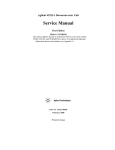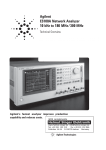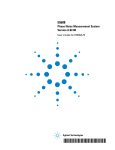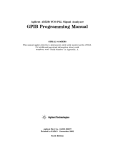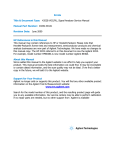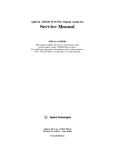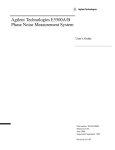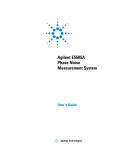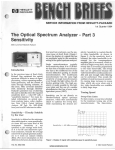Download Agilent Technologies 4352B Instruction manual
Transcript
Safety Summary When you notice any of the unusual conditions listed below, immediately terminate operation and disconnect the power cable. Contact your local Agilent Technologies sales representative or authorized service company for repair of the instrument. If you continue to operate without repairing the instrument, there is a potential fire or shock hazard for the operator. n Instrument operates abnormally. n Instrument emits abnormal noise, smell, smoke or a spark-like light during the operation. n Instrument generates high temperature or electrical shock during operation. n Power cable, plug, or receptacle on instrument is damaged. n Foreign substance or liquid has fallen into the instrument. Caution Do not exceed the operating input power, voltage, and current level and signal type appropriate for the instrument being used, refer to your instrument's Function Reference. Electrostatic discharge(ESD) can damage the highly sensitive microcircuits in your instrument. ESD damage is most likely to occur as the test fixtures or cables are being connected or disconnected. Protect them from ESD damage by wearing a grounding strap that provides a high resistance path to ground. Alternatively, ground yourself to discharge any static charge built-up by touching the outer shell of any grounded instrument chassis before touching the test port connectors. The measurement input terminal "RF-IN" is vulnerable to ESD. Attaching the power limitter to the terminal can effectively minimize ESD damage which may occur in your instrument. 43521A Agilent 43521A Downconverter Unit Operation Manual Agilent Part No. 43521-90010 Printed in JAPAN July 2003 Fourth Edition Notice The information contained in this document is subject to change without notice. This document contains proprietary information that is protected by copyright. All rights are reserved. No part of this document may be photocopied, reproduced, or translated to another language without the prior written consent of the Agilent Technologies Japan, Ltd. Agilent Technologies Japan, Ltd. Component Test PGU-Kobe 1-3-2, Murotani, Nishi-ku, Kobe-shi, Hyogo, 651-2241 Japan c Copyright 1999, 2002, 2003 Agilent Technologies Japan, Ltd. Manual Printing History The manual's printing date and part number indicate its current edition. The printing date changes when a new edition is printed. (Minor corrections and updates that are incorporated at reprint do not cause the date to change.) The manual part number changes when extensive technical changes are incorporated. July 1999 First Edition (part number: 43521-90000) December 1999 Second Edition (part number: 43521-90000) September 2002 Third Edition (part number: 43521-90000) July 2003 Fourth Edition (part number: 43521-90010) ::::::::::::::::::::::::::::::::::::::::::::: :::::::::::::::::::::::::::::::::::: ::::::::::::::::::::::::::::::::::::: :::::::::::::::::::::::::::::::::::::::::: iii Safety Summary The following general safety precautions must be observed during all phases of operation, service, and repair of this instrument. Failure to comply with these precautions or with specic WARNINGS elsewhere in this manual may impair the protection provided by the equipment. In addition it violates safety standards of design, manufacture, and intended use of the instrument. The Agilent Technologies assumes no liability for the customer's failure to comply with these requirements. Note 43521A complies with INSTALLATION CATEGORY II and POLLUTION DEGREE 2 in IEC61010-1. 43521A is an INDOOR USE product. Note LEDs in 43521A are Class 1 in accordance with IEC60825-1. CLASS 1 LED PRODUCT Ground The Instrument To avoid electric shock hazard, the instrument chassis and cabinet must be connected to a safety earth ground by the supplied power cable with earth blade. DO NOT Operate In An Explosive Atmosphere Do not operate the instrument in the presence of ammable gasses or fumes. Operation of any electrical instrument in such an environment constitutes a denite safety hazard. Keep Away From Live Circuits Operating personnel must not remove instrument covers. Component replacement and internal adjustments must be made by qualied maintenance personnel. Do not replace components with the power cable connected. Under certain conditions, dangerous voltages may exist even with the power cable removed. To avoid injuries, always disconnect power and discharge circuits before touching them. DO NOT Service Or Adjust Alone Do not attempt internal service or adjustment unless another person, capable of rendering rst aid and resuscitation, is present. DO NOT Substitute Parts Or Modify Instrument Because of the danger of introducing additional hazards, do not install substitute parts or perform unauthorized modications to the instrument. Return the instrument to a Agilent Technologies Sales and Service Oce for service and repair to ensure that safety features are maintained. iv Dangerous Procedure Warnings Warnings , such as the example below, precede potentially dangerous procedures throughout this manual. Instructions contained in the warnings must be followed. Warning Dangerous voltages, capable of causing death, are present in this instrument. Use extreme caution when handling, testing, and adjusting this instrument. v Typeface Conventions Bold Italics Computer 4HARDKEYS5 NNNNNNNNNNNNNNNNNNNNNNNNNN SOFTKEYS vi Boldface type is used when a term is dened. For example: icons are symbols. Italic type is used for emphasis and for titles of manuals and other publications. Italic type is also used for keyboard entries when a name or a variable must be typed in place of the words in italics. For example: copy lename means to type the word copy, to type a space, and then to type the name of a le such as file1. Computer font is used for on-screen prompts and messages. Labeled keys on the instrument front panel are enclosed in 4 5. Softkeys located to the right of the LCD are enclosed in . NNNNN Certication Agilent Technologies certies that this product met its published specications at the time of shipment from the factory. Agilent Technologies further certies that its calibration measurements are traceable to the United States National Institute of Standards and Technology, to the extent allowed by the Institution's calibration facility, or to the calibration facilities of other International Standards Organization members. Documentation Warranty The material contained in this document is provided \as is," and is subject to being changed, without notice, in future editions. Further, to the maximum extent permitted by applicable law, Agilent disclaims all warranties, either express or implied with regard to this manual and any information contained herein, including but not limited to the implied warranties of merchantability and tness for a particular purpose. Agilent shall not be liable for errors or for incidental or consequential damages in connection with the furnishing, use, or performance of this document or any information contained herein. Should Agilent and the user have a separate written agreement with warranty terms covering the material in this document that conict with these terms, the warranty terms in the separate agreement will control. Exclusive Remedies The remedies provided herein are buyer's sole and exclusive remedies. Agilent Technologies shall not be liable for any direct, indirect, special, incidental, or consequential damages, whether based on contract, tort, or any other legal theory. Assistance Product maintenance agreements and other customer assistance agreements are available for Agilent Technologies products. For any assistance, contact your nearest Agilent Technologies Sales and Service Oce. Addresses are provided at the back of this manual. vii Safety Symbols General denitions of safety symbols used on equipment or in manuals are listed below. Instruction manual symbol: the product is marked with this symbol when it is necessary for the user to refer to the instruction manual. Alternating current. Direct current. On (Supply). O (Supply). In position of push-button switch. Out position of push-button switch. Frame (or chassis) terminal. A connection to the frame (chassis) of the equipment which normally include all exposed metal structures. This Warning sign denotes a hazard. It calls attention to a procedure, practice, condition or the like, which, if not correctly performed or adhered to, could result in injury or death to personnel. This Caution sign denotes a hazard. It calls attention to a procedure, practice, condition or the like, which, if not correctly performed or adhered to, could result in damage to or destruction of part or all of the product. This Note sigh denotes important information. It calls attention to a procedure, practice, condition or the like, which is essential to highlight. Axed to product containing static sensitive devices use anti-static handling procedures to prevent electrostatic discharge damage to component. viii Contents 1. Unpacking and Checking the Contents of the Shipment Incoming Inspection . . . . . . . . . . . . . . . . . . . . . . . . . . . . . Contents of the Shipment . . . . . . . . . . . . . . . . . . . . . . . . . . 2. Connecting 43521A Notes on Installation . . . . . . . . . . . . . . . . . . Requirements for Operating Environment . . . . . . . Providing clearance to dissipate heat at installation site Instruction for Cleaning . . . . . . . . . . . . . . . Connection to the 4352B and External Signal Source . . . Connections on the Front Panel . . . . . . . . . . . . Connections on the Rear Panel . . . . . . . . . . . . Power Requirements . . . . . . . . . . . . . . . . . . Ratings of the Power Source . . . . . . . . . . . . . Power Cable . . . . . . . . . . . . . . . . . . . . . 3. Front Panel and Rear Panel Front Panel . . . . . . . . . . 1. RF Input Connector . . . . 2. RF Output Connector . . . 3. LO Output Connector . . . 4. LO Input Connector . . . . 5. Line Switch . . . . . . . . Rear Panel . . . . . . . . . . 1. 40 MHz Input Terminal . . 2. I/O Port . . . . . . . . . 3. Inlet . . . . . . . . . . . 4. 600 MHz Adjustment Knob Replacing the Fuse . . . . Replacing the Fuse . . . . . . . . . . . . . . . . . . . . . . . . . . . . . . . . . . . . . . . . . . . . . . . . . . . . . . . . . . 1-1 1-1 . . . . . . . . . . . . . . . . . . . . . . . . . . . . . . . . . . . . . . . . . . . . . . . . . . . . . . . . . . . . . . . . . . . . . . . . . . . . . . . . . . . . . . . . . . . . . . . . . . . . . . . . . . . . . . 2-1 2-1 2-1 2-2 2-2 2-3 2-4 2-5 2-5 2-5 . . . . . . . . . . . . . . . . . . . . . . . . . . . . . . . . . . . . . . . . . . . . . . . . . . . . . . . . . . . . . . . . . . . . . . . . . . . . . . . . . . . . . . . . . . . . . . . . . . . . . . . . . . . . . . . . . . . . . . . . . . . . . . . . . . . . . . . . . . . . . . . . . . . . . . . . . . . . . . . . . . . . . . . . . . . . . . . . . . . . . . . . . . . . . . . . . . . . . . . . . . . . . . . . . . . . . . . . . . . . . . . . . . . . . . . . . . . . . . . . . . . . . . . 3-1 3-2 3-2 3-2 3-2 3-2 3-3 3-3 3-3 3-3 3-3 3-4 3-4 Rack/Handle Installation . . . . . . . . . Option 1CN Handle Kit . . . . . . . . . Installing the Handle . . . . . . . . . Option 1CM Rack Mount Kit . . . . . . Mounting into the Rack . . . . . . . Option 1CP Rack Mount & Handle Kit . . Mounting into the Rack (with Handles) . . . . . . . . . . . . . . . . . . . . . . . . . . . . . . . . . . . . . . . . . . . . . . . . . . . . . . . . . . . . . . . . . . . . . . . . . . . . . . . . . . . . . . . . . . . . . . . . . . . . . . . . . . . . . . . . . . . . . . . . . . . . . . 4-1 4-2 4-2 4-2 4-2 4-2 4-2 4. Rack/Handle Installation Contents-1 5. Specications Specications of the 43521A . . . . . . . . . . . . . . . . . . . . . . . . RF Power Measurement . . . . . . . . . . . . . . . . . . . . . . . . . Operating Environment . . . . . . . . . . . . . . . . . . . . . . . . Non-Operating Environment . . . . . . . . . . . . . . . . . . . . . . Others . . . . . . . . . . . . . . . . . . . . . . . . . . . . . . . . System Specications . . . . . . . . . . . . . . . . . . . . . . . . . . . 1. When Frequency Band is 10 MHz to 3 GHz . . . . . . . . . . . . . . . . RF Power Measurement (common to the tester mode and the analyzer mode) 2. When Frequency Band is other than 10 MHz to 3 GHz . . . . . . . . . . . 2-1. Tester Mode . . . . . . . . . . . . . . . . . . . . . . . . . . . . . RF Power Measurement . . . . . . . . . . . . . . . . . . . . . . . . Frequency Measurement . . . . . . . . . . . . . . . . . . . . . . . . FM Deviation Measurement . . . . . . . . . . . . . . . . . . . . . . C/N Ratio Measurement . . . . . . . . . . . . . . . . . . . . . . . . 2-2. Analyzer Mode . . . . . . . . . . . . . . . . . . . . . . . . . . . RF Power Characteristics vs. DC Control Voltage Measurement . . . . . . Frequency/Tuning Sensitivity Characteristics vs. DC Control Voltage Measurement . . . . . . . . . . . . . . . . . . . . . . . . . . . . Phase Noise Characteristics vs. Oset Frequency Measurement . . . . . . Frequency Transient Measurement . . . . . . . . . . . . . . . . . . . Spectrum Measurement . . . . . . . . . . . . . . . . . . . . . . . . . . . . . . . . . . . . . . . . 5-1 5-1 5-2 5-2 5-2 5-3 5-3 5-3 5-3 5-3 5-3 5-3 5-3 5-3 5-4 5-4 . . . . 5-4 5-4 5-4 5-4 Introduction . . . . . . . . . . . . . . . . . . . . . . . . . . . . . . . . . Manual Changes . . . . . . . . . . . . . . . . . . . . . . . . . . . . . . . Serial Number . . . . . . . . . . . . . . . . . . . . . . . . . . . . . . . . A-1 A-1 A-2 A. Manual Changes Contents-2 Figures 2-1. 2-2. 2-3. 3-1. 3-2. 4-1. A-1. Connections on the Front Panel . Connections on the Rear Panel . Optional Power Cables . . . . . Front Panel . . . . . . . . . . rear panel . . . . . . . . . . . Rack Mount Kit Installation . . Serial Number Plate . . . . . . . . . . . . . . . . . . . . . . . . . . . . . . . . . . . . . . . . . . . . . . . . . . . . . . . . . . . . . . . . . . . . . . . . . . . . . . . . . . . . . . . . . . . . . . . . . . . . . . . . . . . . . . . . . . . . . . . . . . . . . . . . . . . . . . . . . . . . . . . . . . . . . . . . . . . . . . . . 2-3 2-4 2-6 3-1 3-3 4-1 A-2 List of the Contents of the Shipment Parts Used on the Front Panel . . . Parts Used on the Rear Panel . . . . Rating of Fuse . . . . . . . . . . . Rack Mount Kits . . . . . . . . . . RF Power Measurement Accuracy . . Noise Floor of Phase Noise . . . . . Manual Changes by Serial Number . . . . . . . . . . . . . . . . . . . . . . . . . . . . . . . . . . . . . . . . . . . . . . . . . . . . . . . . . . . . . . . . . . . . . . . . . . . . . . . . . . . . . . . . . . . . . . . . . . . . . . . . . . . . . . . . . . . . . . . . . . . . . . . . . . . . . . . . . . . . . . . . . . . . . . . . . . . . . . . . . 1-1 2-3 2-4 3-4 4-1 5-1 5-4 A-1 Tables 1-1. 2-1. 2-2. 3-1. 4-1. 5-1. 5-2. A-1. Contents-3 Unpacking and Checking the Contents of the Shipment 1 This chapter describes how to check the shipping container of your 43521A ( Downconverter Unit), the appearance of the product, and the contents of the shipment. Incoming Inspection When you receive the product, inspect the shipping container for damage. If the shipping container or cushioning material is damaged, it should be kept until the contents of the shipment have been checked for completeness and the 43521A has been checked mechanically and electrically. The contents of the shipment should be as listed in Table 1-1. If the contents are incomplete, if there is mechanical damage or defect, notify the nearest Agilent Technologies sales oce. If the shipping container is damaged, or the cushioning material shows signs of unusual stress, notify the carrier as well as the Agilent Technologies oce. Keep the shipping materials for the carrier's inspection. Warning To avoid hazardous electrical shock, do not turn on the 43521A when there are signs of shipping damage to any portion of the outer enclosure (for example, covers, panel, or display). Contents of the Shipment The 43521A (Downconverter Unit) includes the following items. Check to see that the contents are complete. If not, contact your nearest Agilent Technologies Sales and Service Oce. Table 1-1. List of the Contents of the Shipment Name Downconverter Unit BNC cable (30 cm x 1) N-N cable (18 cm x 2) N-N cable (50 cm x 1) 15-pin D-Sub cable CD-ROM (for manuals)1 Power cable 43521A Operation Manual (Option ABA only) Agilent Part Number 43521A 8120-1838 8120-4387 43521-61638 04380-61601 43521-9050x2 8120-4753 43521-900x02 1 CD-ROM contains the contents of the Operation Manual. 2 The number indicated by \x" in the part number is allocated for numbers increased by one each time a revision is made. The latest edition comes with the product. Unpacking and Checking the Contents of the Shipment 1-1 2 Connecting 43521A The 43521A (Downconverter Unit) is used as part of the 4352S (VCO/PLL Signal Test System). Using the 43521A expands the maximum frequency of the 4352S to 12.6 GHz. This chapter describes how to make connection for the 4352S when associated with the 43521A. How to use the entire 4352S including the 43521A is described in Chapter 5 of the 4352B Function Reference, while a quick guide to diagnosis is provided in Appendix F of that document. For related sample programs, see \Frequency Transient Measurement" in Chapter 12 of the 4352B GPIB Programming Manual. After the completion of the connection for the 4352S, proceed to the reference. Note that the 4352B with the rmware of Rev 2.00 or greater is required in order to operate the 43521A. Notes on Installation Requirements for Operating Environment The requirements for the operating environment of the 43521A is the same as those of the 4352B. Use it under the environment shown below. Temerature: 0 C to 40 C Humidity: Relative humidity of 95% or less (at 40 C) Note The 43521A must be protected from temperature extremes which could cause condensation within the instrument. Providing clearance to dissipate heat at installation site To ensure the specications and measurement accuracy of the product, you must keep ambient temperature around the product within the specied range by providing appropriate cooling clearance around the product or, for the rackmount type, by forcefully air-cooling inside the rack housing. For information on ambient temperature to satisfy the specications and measurement accuracy of the product, refer to \Specications" in Chapter 5. When the ambient temperature around the product is kept within the temperature range of the operating environment specication (refer to \Operating Environment" in Chapter 5), the product conforms to the requirements of the safety standard. Furthermore, under that temperature environment, it has been conrmed that the product still conforms to the requirements of the safety standard when it is enclosed with cooling clearance as follows: Connecting 43521A 2-1 Conditions Rear 180 mm Side 60 mm Instruction for Cleaning To prevent electrical shock, disconnect the 43521A's power cable from the power outlet before cleaning. To clean the exterior of the 43521A, wipe the surfaces with a dry cloth or a soft cloth that is soaked with water and wrung tightly, without undue pressure. Do not attempt to clean the 43521A internally. Connection to the 4352B and External Signal Source The 43521A is used by connecting it to the 4352B (VCO/PLL Signal Analyzer) and the external signal source. To operate the 43521A, the 4352B with the rmware of Rev 2.00 or greater is required. All parts required for the connection including cables and connectors will come with the 43521A and the 4352B. For the information on the accessories of the 4352B, refer to Chapter 3 of the 4352B Function Reference. 2-2 Connecting 43521A Connections on the Front Panel Make connections as shown in Figure 2-1. For how to connect a DUT (Device Under Test), refer to Chapter 5 of the 4352B Function Reference. Figure 2-1. Connections on the Front Panel No. Name 1 N-N cable (18 cm x 2) 2 N-N cable Table 2-1. Parts Used on the Front Panel Connection Locations Agilent Part Number 8120-4387 41951-61602 (accessory of the 4352B) The RF IN connector of the 4352B and the RF OUT connector of the 43521A, the LO IN connector of the 4352B and the LO OUT connector of the 43521A The FR output connector of the external signal generator and the LO IN connector of the 43521A Connecting 43521A 2-3 Connections on the Rear Panel Make connections as shown in Figure 2-2. Figure 2-2. Connections on the Rear Panel No. Name 1 BNC-BNC connector Table 2-2. Parts Used on the Rear Panel Connection Locations Agilent Part Number 2 BNC-BNC cable 1250-1859 (accessory of the 4352B) 8120-1838 3 15-pin D-Sub cable 04380-61601 4 BNC-BNC cable 8120-1839 (accessory of the 4352B) 10833A (accessory of the 4352B) (30 cm) (60 cm) 5 GPIB cable 2-4 Connecting 43521A The 2ND IF Output connector and the 2ND IF Input connector of the 4352B The 40MHz Output connector of the 4352B and the 40MHz Input connector of the 43521A The I/O PORT connector of the 4352B and the I/O PORT connector of the 43521A The EXT REF Input connector of the 4352B and the 10MHz OUT connector of the external signal generator The GPIB connector of the 4352B and the GPIB connector of the external signal generator Power Requirements Ratings of the Power Source The 43521A requires the following power source: Voltage : 90 to 132 Vac or 198 to 264 Vac Frequency : 47 to 63 Hz Power : 100 VA maximum Power Cable In accordance with international safety standards, this instrument is equipped with a three-wire power cable. When connected to an appropriate ac power outlet, this cable grounds the instrument frame. The type of power cable shipped with each instrument depends on the country of destination. Refer to Figure 2-3 for the part numbers of the power cables available. Warning For protection from electrical shock, the power cable ground must not be defeated. The power plug must be plugged into an outlet that provides a protective earth ground connection. Connecting 43521A 2-5 Figure 2-3. Optional Power Cables 2-6 Connecting 43521A 3 Front Panel and Rear Panel This chapter explains the front and rear panels of the 43521A (Downconverter Unit). How to use the entire 4352S including the 43521A is described in Chapter 5 of the 4352B Function Reference. Related sample programs are found in \Frequency Transient Measurement" in Chapter 12 of the 4352B GPIB Programming Manual. Front Panel Figure 3-1 shows the conguration of the front panel. Figure 3-1. Front Panel Front Panel and Rear Panel 3-1 1. RF Input Connector Receives the RF output signal from the device under test (signal to be measured). INSTALLATOIN CATEGORY I 2. RF Output Connector The RF signal (signal to be measured) inputted to the RF input connector is outputted from this connector, and sent to the RF input connector of the 4352B (VCO/PLL Signal Analyzer) through the N-N cable. When the frequency band setting of this test system is 10 MHz to 3 GHz, the signal inputted to the RF input connector is outputted from this connector as it is. When the frequency band setting is not 10 MHz to 3 GHz, it is converted to an IF frequency signal and then outputted. 3. LO Output Connector The signal from this connector is sent to the LO IN connector of the 4352B ( VCO/PLL Signal Analyzer) through the N-N cable. The signal outputted from this connector is as follows: if the frequency band setting of this test system is 10 MHz to 3 GHz, the signal inputted to the LO input connector is outputted; if it is outside of 10 MHz to 3 GHz, the signal from the internal oscillator of the 43521A (600 MHz) is outputted. 4. LO Input Connector Receives the output signal from the external signal generator. 5. Line Switch Toggles on/o the power each time the button is pressed. j and indicate ON and OFF, respectively. When the switch is ON, the right lamp is lit in green. 3-2 Front Panel and Rear Panel Rear Panel Figure 3-2 shows the conguration of the rear panel. Figure 3-2. rear panel 1. 40 MHz Input Terminal To improve the frequency accuracy of the 600-MHz signal inside the 43521A, the 40-MHz signal from the rear panel of the 4352B (VCO/PLL Signal Analyzer) is inputted to this connector to provide phase locking for synchronizing the 600-MHz signal to the 40-MHz signal. 2. I/O Port Receives the digital signal from the I/O port connector on the rear panel of the 4352B. All operations of the 43521A are controlled by this signal. 3. Inlet Connects the power cable to this inlet. To replace the fuse, please see \Replacing the Fuse" in this chapter. 4. 600 MHz Adjustment Knob Adjusts the frequency of the 600-MHz signal outputted from the LO output connector. For usual use, adjustment is not required. It is required only at periodical calibration of the 43521A. For details, refer to the 43521A Service Manual. Front Panel and Rear Panel 3-3 Replacing the Fuse Select a proper fuse according to the Table 3-1. Table 3-1. Rating of Fuse Rating Part Number 3A 250Vac UL/CSA type Time delay 2110-0381 For ordering the fuse, contact your nearest Agilent Technologies Sales and Service Oce. Replacing the Fuse Lever a small minus screwdriver to dismount the fuse holder next to the AC line receptacle on the rear panel. Caution Replace the fuse in the fuse holder. When replacing the fuse, be sure to check that the rating and the type are correct. Do not use a repaired fuse or short-circuited fuse holder. 3-4 Front Panel and Rear Panel 4 Rack/Handle Installation Rack/Handle Installation This instrument can be rack-mounted and used as a component in a measurement system. Figure 4-1 shows how to rack-mount the instrument. Option Table 4-1. Rack Mount Kits Description 1CN 1CM 1CP Front Handle Kit Rack Mount Kit Rack Mount & Handle Kit Agilent Part Number 5063-9226 5063-9212 5063-9219 Figure 4-1. Rack Mount Kit Installation Rack/Handle Installation 4-1 Option 1CN Handle Kit Option 1CN includes a pair of handles and accessories to attach them to the instrument. Installing the Handle 1. Remove the cosmetic panels 1 axed to both sides of the frame on the front panel. (See Figure 4-1.) 2. Attach the handles 3 to both sides of the instrument using the screws provided. 3. Attach the trim strips 4 to the handles. Option 1CM Rack Mount Kit Option 1CM includes a pair of anges and accessories to mount the instrument to an EIA-compliant standard rack (482.6 mm wide). Mounting into the Rack 1. Remove the cosmetic panels 1 axed to both sides of the frame on the front panel. (See Figure 4-1.) 2. Attach the anges 2 to both sides of the instrument using the screws provided. 3. Remove all the four feet. (Lift the tab and slide the foot in the arrow direction.) 4. Mount the instrument into the rack. Option 1CP Rack Mount & Handle Kit Option 1CP includes a pair of anges, handles, and accessories. Mounting into the Rack (with Handles) 1. Remove the cosmetic panels 1 axed to both sides of the frame on the front panel. (See Figure 4-1.) 2. Attach the handles 3 and the anges 5 to both sides of the instrument using the screws provided. 3. Remove all the four feet. (Lift the tab and slide the foot in the arrow direction.) 4. Mount the instrument into the rack. 4-2 Rack/Handle Installation 5 Specications The specications mean the performance standards and operation limits. They are the 43521A's performance guaranteed, unless otherwise specied, over the temperature range of 0 C to 40 C and after a warm-up time of at least 30 minutes has elapsed from power-on. Information provided as typical, reference, or approximate, though not specications, is intended to serve as reference data for ecient operation of the 43521A. Specications of the 43521A RF Power Measurement Frequency band VSWR Input level :::::::::::::::::::::::::::::::::::::::::::::::::::::::::: 2.4 GHz to 12.6 GHz 1.5 :::::::::::::::::::::::::::::::::::::::::::::::::::::::::::::::::::::::::::::::::::::::< When the input attenuator is 0 dB: When the input attenuator is 0 dB: 020 dBm to 0 dBm 020 dBm to +20 dBm ::::::::::::::::::::::::::::::::::::::: Resolution Measurement accuracy > :::::::::::::::::::::::::::::::::: 0.01 dB Table 5-1 :::::::::::::::::::::::::::::::::::::::::::::::::::::::::::::::::::::::::::::: ::::::::::::::::::::::::::::::::::::::::::::::::::::::::::::::: Table 5-1. RF Power Measurement Accuracy Temperature Range Level of Input Signal 0 to 40 C 23610 C 2.4 GHz to 8 GHz 62.0 dB 2.4 GHz to 4 GHz 61.5dB -20 dBm to 0 dBm 8 GHz to 12.6 GHz 62.5 dB 4 GHz to 8 GHz 62.0 dB (ATT=0dB) 8 GHz to 12.6 GHz 62.5 dB 2.4 GHz to 4 GHz 61.5 dB 15 dBm (Same as left) 4 GHz to 8 GHz 62.0 dB (ATT 0 dB) 8 GHz to 12.6 GHz 62.5 dB 2.4 GHz to 4 GHz 61.5 dB 20 dBm > (ATT 0 dB) > (Reference) 4 GHz to 8 GHz 62.0 dB (Reference) 8 GHz to 12.6 GHz 62.5 dB (Reference) (Same as left) * Peak voltage response * The above specications are applicable when the 43521A is controlled by the 4352B and the measurement result is displayed on the 4352B. @6 GHz,-5 dBm,23610 C @12 GHz,-5 dBm,23610 C :::::::::::::::::::::::::::::::::::::::::::::::::::::: ::::::::::::::::::::::::::::::::::::::::::::::::::::: 60.8 dB(Typical) 61.0 dB(Typical) Specications 5-1 Operating Environment Temperature Humidity Altitude Warm up time 0 C to 40 C 15% to 95% RH 0 to 2000 m 30 minutes ::::::::::::::::::::::::::::::::::::::::::::::::::::::::::::::::::::::: ::::::::::::::::::::::::::::::::::::::::::::::::::::::::::::::::::::::: :::::::::::::::::::::::::::::::::::::::::::::::::::::::::::::::::::::::::::: ::::::::::::::::::::::::::::::::::::::::::::::::::::::::::::::::::::::: Non-Operating Environment Temperature Humidity :::::::::::::::::::::::::::::::::::::::::::::::::::::::::::::::::::: ::::::::::::::::::::::::::::::::::::::::::::::::::::::::::::::::::::::: @wet bulb temperature 45 C, without condensation Altitude 15% to 95% RH :::::::::::::::::::::::::::::::::::::::::::::::::::::::::::::::::::::::::::: Others EMC 020 C to 60 C :::::::::::::::::::::::::::::::::::::::::::::::::::::::::::: Emission: EN 55011:1991 / CISPR 11:1990 Group 1, Class A Immunity: EN 50082-1:1992 0 to 4572 m Complies with those standards EN/IEC 61000-3-2 1995 EN/IEC 61000-3-3 1995 EN/IEC 61000-4-2:1995 4 kV CD / 8 kV AD EN/IEC 61000-4-3:1995 3 V/m, 27-1000 MHz, 80 % AM EN/IEC 61000-4-4:1995 Main 1 kV / Signal 0.5kV EN/IEC 61000-4-5:1995 Common 2 kV / Normal 1 kV EN/IEC 61000-4-6:1996 3 V, 0.15-80 MHz, Main This ISM device complies with Canadian ICES-001. Cet appareil ISM est conforme a la norme NMB-001 du Canada. Safety ::::::::: A2(1995) Complies with EN61010-1(1993) + A2(1995)/IEC 61010-1(1990) + A1(1992) + Power requirements Weight Dimensions RF input terminal (Reference) ::::::::::::: Complies with CSA C22.2 No.1010.1-92 90 V to 132 V, or 198 V to 264 V, 47 to 63 Hz, 100 VA max 8 kg max 425(W) 2 101(H) 2 553(D) mm ::::::::::::::::::::::::::::::::::::::::::::::::::::::::::::::::::::::::::::::::: ::::::::::::::::::::::::::::::::::::::::::::::::::::: Heterodyne path gain Insertion Loss in Direct Path: :::::::::::::::::::::::::::::::::::::::::::::::::::::::::: :::::::::::::::::::::::::::::::::::::::::::::::::: LO input terminal (Reference) Input level Frequency range Insertion Loss in Direct Path: 20 dB @ 6 GHz 0.5dB @ 3 GHz +10 dBm 10 MHz to 6 GHz 0.5dB @ 3 GHz ::::::::::::::::::::::::::::::::::::::::::::::::::::::::::::::::::::::::::: ::::::::::::::::::::::::::::::::::::::::::::::::::::::::::::: :::::::::::::::::::::::::::::::::::::::::::::::::: LO output terminal (Reference) 600 MHz Output Level 600 MHz Frequency Accuracy +8 dBm 600 MHz 6 50 ppm :::::::::::::::::::::::::::::::::::::::::::::::::::::::::::::: 5-2 Specications ::::::::::::::::::::::::::::::::::::::::::::: System Specications The following provide the specications of the system in which the 43521A is connected to the 4352B (VCO/PLL Signal Analyzer) and the external signal source. It is assumed that the 43521A is locked by the 40 MHz signal from the 4352B. All values, except for the RF power measurement in 2-1. Tester Mode, are reference values. Note that same specications as those of the 4352B are not shown. 1. When Frequency Band is 10 MHz to 3 GHz RF Power Measurement (common to the tester mode and the analyzer mode) Measurement accuracy When the frequency 2 GHz Add 60.1 dB to the accuracy of the 4352B. When the frequency is 2 GHz to 3 GHz Add 60.2 dB to the accuracy of the 4352B. The same specications as the 4352B are applicable for other measurement parameters. :::::::::::::::::::: :::::::::: 2. When Frequency Band is other than 10 MHz to 3 GHz 2-1. Tester Mode RF Power Measurement Same as the specications of the 43521A. Frequency Measurement Frequency band Resolution Measurement accuracy ::::::::::::::::::::::::::::::::::::::::::::::::::::::::::: 2.4 GHz to 12.6 GHz Same as the 4352B. Same as the 4352B. :::::::::::::::::::::::::::::::::::::::::::::::::::::::::::::::::: :::::::::::::::::::::::::::::::::::::::::::::::::::: FM Deviation Measurement Measurement range Deviation resolution Deviation measurement accuracy Residual FM :::::::::::::::::::::::::::::::::::::::::::::::::::::::: ::::::::::::::::::::::::::::::::::::::::::::::::::::::: :::::::::::::::::::::::::::::::::::::::: :::::::::::::::::::::::::::::::::::::::::::::::::::::::::::::::: Same as the 4352B. Same as the 4352B. Same as the 4352B. Same as the 4352B. C/N Ratio Measurement Oset frequency range Phase noise Same as the 4352B. Table 5-2 The table is applicable when the 8665B (with Option 004) is used as the external signal source. If the external signal source is the 8664A (with Option 004), use values of up to 6 GHz; if it is the 8665A (with Option 004), use values of up to 9 GHz. :::::::::::::::::::::::::::::::::::::::::::::::::::: ::::::::::::::::::::::::::::::::::::::::::::::::::::::::::::::::::::::::::: Specications 5-3 Table 5-2. Noise Floor of Phase Noise Oset Freq (Hz) 100 300 600 1k 3k 6k 10k 30k 60k 100k 300k 600k 1M 3M 6M 9M RF Freq 3 GHz -68 -75 -85 -93 -111 -120 -125 -132 -135 -137 -145 -149 -150 -151 -151 -151 6 GHz -63 -68 -79 -88 -106 -115 -119 -126 -129 -131 -139 -144 -147 -149 -150 -150 9 GHz -57 -65 -76 -84 -101 -109 -114 -120 -123 -125 -133 -139 -143 -145 -145 -146 12 GHz -58 -63 -73 -81 -99 -108 -113 -120 -123 -125 -134 -138 -142 -145 -147 -147 Measurement accuracy :::::::::::::::::::::::::::::::::::::::::::::::::::: Same as the 4352B. 2-2. Analyzer Mode RF Power Characteristics vs. DC Control Voltage Measurement Same as the RF Power Measurement in the 43521A. Frequency/Tuning Sensitivity Characteristics vs. DC Control Voltage Measurement Same as the frequency measurement in the tester mode. Phase Noise Characteristics vs. Oset Frequency Measurement Same as the C/N ratio measurement in the tester mode. Frequency Transient Measurement Frequency accuracy Frequency span Measurement resolution Same as the 4352B. 2 MHz, 20 MHz, 512 MHz (MAX) 50 Hz, 500 Hz, 12.8 kHz (MAX) ::::::::::::::::::::::::::::::::::::::::::::::::::::::: ::::::::::::::::::::::::::::::::::::::::::::::: :::::::::::::::::::::::::::::::::::::: Spectrum Measurement When the detection mode is specied to positive peak Absolute level accuracy For @010 dBm input, attenuator = 10 dB, Relative level accuracy ::::::::::::::::::::::::::::::::::::::::::: :::::::::::::::::::::::::::::::::::::::::::::::::::: 5-4 Specications 63dBm Same as the 4352B. A Manual Changes Introduction This appendix contains the information required to adapt this manual to earlier versions or congurations of the 43521A than the current printing date of this manual. The information in this manual applies directly to the 43521A serial number prex listed on the title page of this manual. Manual Changes To adapt this manual to your 43521A see Table A-1 and make all the manual changes listed opposite your instrument's serial number and rmware version. Instruments manufactured after the printing of this manual may be dierent from those documented in this manual. Later instrument versions will be documented in a manual changes supplement that will accompany the manual shipped with that instrument. If your instrument's serial number is not listed on the title page of this manual or in Table A-1, it may be documented in a yellow MANUAL CHANGES supplement. In additions to change information, the supplement may contain information for correcting errors (Errata) in the manual. To keep this manual as current and accurate as possible, Agilent Technologies recommends that you periodically request the latest MANUAL CHANGES supplement. For information concerning serial number prexes not listed on the title page or in the MANUAL CHANGE supplement, contact the nearest Agilent Technologies oce. Table A-1. Manual Changes by Serial Number Make Manual Changes Serial Prex or Number Not Applicable Manual Changes A-1 Serial Number Agilent Technologies uses a two-part, ten-character serial number that is stamped on the serial number plate (Refer to Figure A-1) attached to the rear panel. The rst ve characters are the serial prex and the last ve digits are the sux. Figure A-1. Serial Number Plate A-2 Manual Changes REGIONAL SALES AND SUPPORT OFFICES For more information about Agilent Technologies test and measurement products, applications, services, and for a current sales office listing, visit our web site: http://www.agilent.com/find/tmdir. You can also contact one of the following centers and ask for a test and measurement sales representative. 11/29/99 United States: Agilent Technologies Test and Measurement Call Center P.O.Box 4026 Englewood, CO 80155-4026 (tel) 1 800 452 4844 Canada: Agilent Technologies Canada Inc. 5150 Spectrum Way Mississauga, Ontario L4W 5G1 (tel) 1 877 894 4414 Europe: Agilent Technologies Test & Measurement European Marketing Organization P.O.Box 999 1180 AZ Amstelveen The Netherlands (tel) (31 20) 547 9999 Japan: Agilent Technologies Japan Ltd. Call Center 9-1, Takakura-Cho, Hachioji-Shi, Tokyo 192-8510, Japan (tel) (81) 426 56 7832 (fax) (81) 426 56 7840 Latin America: Agilent Technologies Latin American Region Headquarters 5200 Blue Lagoon Drive, Suite #950 Miami, Florida 33126 U.S.A. (tel) (305) 267 4245 (fax) (305) 267 4286 Australia/New Zealand: Agilent Technologies Australia Pty Ltd 347 Burwood Highway Forest Hill, Victoria 3131 (tel) 1-800 629 485 (Australia) (fax) (61 3) 9272 0749 (tel) 0 800 738 378 (New Zealand) (fax) (64 4) 802 6881 Asia Pacific: Agilent Technologies 24/F, Cityplaza One, 1111 King’s Road, Taikoo Shing, Hong Kong (tel) (852)-3197-7777 (fax) (852)-2506-9284










































